Boring Brand? How To Create a Unique Brand and Market Positioning
Brand Positioning is not a new concept. Identified by Jack Trout and Al Ries in 1980, brand positioning is recognized as one of the most effective ways to become a market and industry leader. Since the “Positioning: The Battle for Your Mind” [1] book was published, thousands of companies used the concept to formulate a concise version of their vision.
Related: CEO Brand Leadership, How Vision Drives Brand Growth
While the book makes developing a brand positioning statement look easy, the reality is many businesses and organisations end up with meaningless statements. For example, “We’re the best web development agency that helps clients achieve their goals” is a pompous, meaningless statement that doesn’t communicate value to the customer on their terms i.e What’s in it for them? In a sceptical, information overloaded world, a statement such as this evokes doubts, not admiration.
In order for your brand to have an impact, you need to craft a positioning statement, that clearly defines why you’re different from others while also reflecting your strengths and competitors’ weaknesses.
Creating a strong brand positioning statement is a complex science. So before we give you a step-by-step guide, let’s dive deeper into complexities of the jargon.
If you want to become empowered to transform your brand and shape your positioning to increase your sales then the Persona Brand Building Blueprint™ Mastermind is the perfect fit for you. This is a two-day brand building intensive shared with a small group of like-minded peers where you work on your brand with our leadership. Discover more here.

Build your standout brand at the Persona Brand Building Blueprint™ Mastermind with Lorraine Carter
What’s Brand Positioning?
Despite the fact that many marketers and entrepreneurs have heard about the concept of brand positioning, only a few can clearly define it. Kotler defines brand positioning as “the act of designing the company’s offering and image to occupy a distinctive place in the mind of a target market”. Simply put, brand positioning illustrates how a brand is different from competitors and where it sits in the customer mind.
Here is why brand positioning is important. When you enter a crowded marketplace you’re expected to be different. If you’re not different, then what is the reason people should buy from you and not from your competitors? Secondly, brand positioning describes your brand’s unique qualities and traits. Brands are, essentially, like people. You can highlight certain traits and suppress others to make your brand more appealing to a particular audience so you can attract your ideal customers. With the right approach and increased awareness of your brand personality, you can get to the core of your brand and express it to the public.
Related: How to Use Brand Positioning to Build Brand Impact in an Overcrowded Market
Expending effort to create a brand positioning statement is similar to learning how to express yourself as a human. As the following video from The School of Life points out, there are no boring people. Since brands are partly an expression of their creators, there can be no boring brands, but you need to work hard to identify and reveal your uniqueness to others.
Are you looking to launch a new product or brand and need to position it properly? Our brand profiling service helps you codify and map out your brand, resulting in your own specific brand blueprint to stand out, attract your ideal customers and build a lasting relationship with them so you can grow your profits. Feel free to get in touch to discover more.
Seven Critical Brand Positioning Concepts
Positioning is something that happens in the mind of the customer.
You might be intentionally working on the positioning of your brand or ignoring it completely, either way, customers will find a way to compartmentalise your brand and put you into a box, good or bad. However, you can positively influence customer perception if you’re being proactive in codifying and mapping out your brand strategically.
In an ideal world, you’d have absolute clarity on your brand positioning long before you finalize your product or service. In this video Kevin Roberts explains the importance of developing your brand before a product or service solution is finalized:
Related: Purposeful Brands, Why Customers Are Prepared to Pay More
This point of view is partly supported by David Skok from For Entrepreneurs[2], who identifies two factors that spur creative thinking and lead to the development of a business idea. These are:
Customer Motivation, that includes an unmet need and entertainment
and
Disruption, that includes new technology or new business model
When the two factors collide, they create a rich ground for brand idea generation. Frequently, novice entrepreneurs focus on one factor only. If you have a tech mind bias, you strive to create the most advanced technology. If you’re a people person, you fall in love with abstract concepts and marketing messages. The fact is, great ideas lie on the verge of opposite realms.
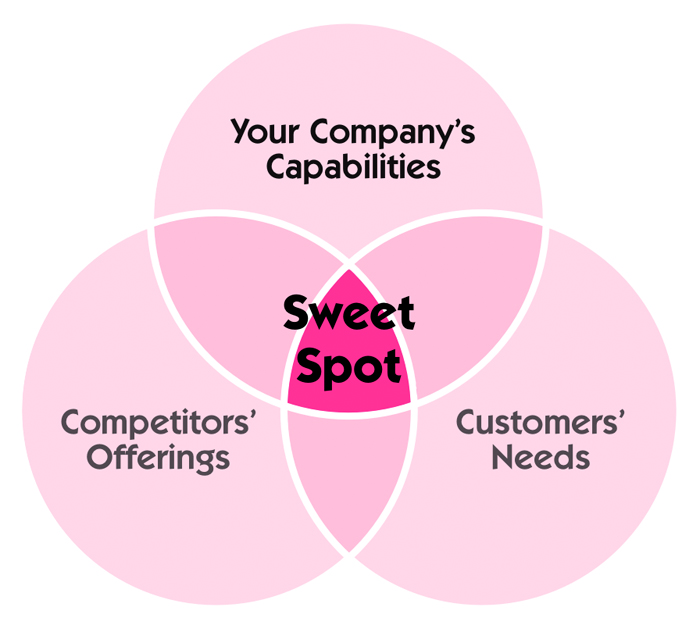
In branding, positioning is a way to combine the two factors in a single message and communicate it to target customers. It’s the continuous and consistent application of your brand strategy in implementation terms that ultimately results in ideal customers becoming aware of your brand and perceiving it to be different, unique and perfect for their needs. Consistent and regular brand message reinforcement with standout positioning across multiple, appropriate communication channels is one of the secret drivers of success, and yet the one most often poorly executed.
Brand positioning requires creative, analytical and critical thinking. If you’re struggling to create strong positioning for your company, product or service or even your personal brand, check out the Personality Profile Performer™ programme. This is a DIY solution enabling you to make your brand stand out with higher perceived value than your competitors so you can increase your sales and your profits.

Start building your standout, highly visible brand now with Lorraine Carter here
If you’d like a one-on-one consultation and a personal brand positioning building session take a look at our Brand Positioning & Profiling Service. As a result of brand profiling, you’ll get a clear understanding and expression of what your business offers, how the business delivers it and what it means for your customers, partners and key audiences so that you can build a brand that’s different, distinctive, likeable and profitable.
7 Critical Brand Positioning Factors
To understand brand positioning, you need to know the seven critical factors that form the core of the concept:
1. Perception
Perception defines how customers see your product. Bear in mind that perception is a neurological concept. According to neuroscience, things we pay attention to are real, while other things don’t exist[3]. Accordingly, in the branding world, all that exists in the customer mind is the reality, everything else is an illusion. Here is how this idea plays out in real life:
Many marketers believe that they have the best product, and since the product is the best, it can win the leading position in the market. But both the belief in having the best product and the belief in having a competitive advantage are marketers’ perceptions, not customers’ perceptions, hence they are not real.
It’s important for brand owners and marketers to recognize when they’re focusing too much on their own perception rather than on creating and moulding customers’ perceptions.
2. Differentiation
Choice is the enemy of sale[4]. When customers have to choose between many similar brands, they fail to make a choice. Brand differentiation is the positioning of your brand against competitors in a meaningful way that makes your brand stand out in the eyes of customers.
Differentiation comes down to unique values that only you and your brand personality can offer. If you own a bookstore and have a wide selection of books, great customer service, and good design interior – you’re just like any other bookstore. But if you run regular book reading meetups, customers who are looking to connect will choose your store over the other.
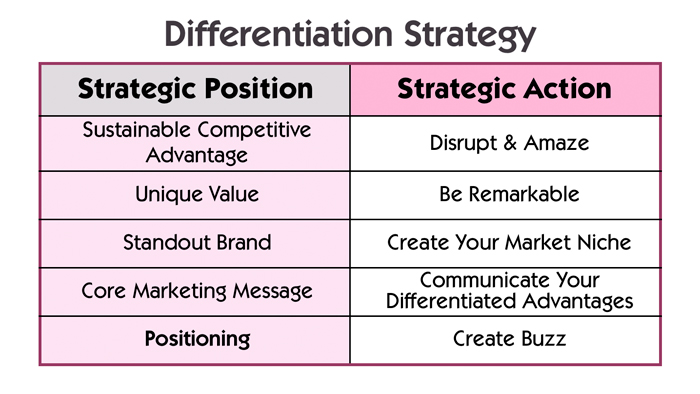
3. Competition
A lot of brand positioning work revolves around competition. A brand is positioned a certain way compared to competitors. This concept is hard to illustrate without examples, so here are the most common brand positions in relation to competitors:
- Defensive position – when your company is the market leader
- Offensive position – when you’re challenging the leader
- Flanking position – when you occupy the 4-6 place in the market
- Guerilla Warfare position – when you occupy and defend a small segment of the market
4. Specialization
Specialization is the ability to focus on what you’re good at. Specialization allows smaller brands to challenge market leaders. When you specialize in one thing you inevitably become an expert and people come to you with particularly difficult problems. Ultimately, specialization is the only way for small business to beat larger brands.
Related: How Do Challenger Brands Become Market Leaders?
5. Simplicity
The concept of simplicity is related to the paradox of choice mentioned earlier. Simplicity allows brands to plough through the clutter of thoughts in the customer mind. People are bombarded by branded messages on a regular basis. So when you present a simple clear idea or a simple way to solve a problem as opposed to overly complicated competitors’ ideas, it gives you an advantage of being seen as helpful and user-friendly. Your brand promise becomes more appealing than those of the competitors.
6. Leadership
The one who comes first always wins. In marketing, the leaders will always take more space in the customer mind compared to the followers[5]. You can become a leader by launching an innovative brand idea, that takes the market by storm, or by slowly conquering the market. Take Coca-Cola, for example. Whenever we talk about cola drinks, we can’t help but think about Coca-Cola. Similarly, when you think about computers, you’ll think about Apple even though Apple might not be considered the best computer in the world by everyone.
Related: Brand Disruption, Be the Disruptor or Be Defeated
7. Reality
Reality goes back to perception. Realty concept states that customer perception is the reality, while everything else is an illusion. When you pay attention to the reality you can reinforce your brand positioning. When you focus on your fantasies and misconceptions, you’re hurting your brand.
Frequently, entrepreneurs have a very distinct perception of their brand so they try to establish it in the customers’ minds. But your target market might see the product or service from a completely different point of view. Your responsibility as a business owner is to recognize misleading thought patterns and channel branding strategy and marketing endeavours in the right direction.
The Difference Between Positioning And USP
Some businesses attempt to use brand positioning and USP synonymously. But these are two different concepts. USP is a unique selling proposition. And as the word “selling” points out, USP is meant to sell. USP is a tool, not a strategy. If one USP doesn’t resonate with your customer, you can invent a new one.
Brand positioning, on the other hand, is a strategic concept, that defines where your company stands in the customer mind comparative to competitors. USP highlights a single benefit or feature, while a brand positioning statement has nothing to do with features, rather it is used to claim an emotional and mental space in the audience’s mind.
Types of Brand Positioning
Businesses usually focus on one of four types of brand positioning:
User-Oriented
This type of brand positioning focuses on one type of user. The CRM company Relenta is leveraging its brand strategy to target older consumers and small businesses, hence their design and logo look is more traditional rather than leading edge appeal. The brand positioning statement “An email-based CRM for people who want to Get Things Done” highlights productivity concepts and online tools that have been around for years and resonate with an older audience. Note that the brand isn’t using any of the current buzz words such as “collaboration”, “agile”, and “big data”.

Image via Relenta
Benefit-Oriented
Benefit-oriented positioning is when a brand defines its position relative to competitors based on the values it brings to customers. In this case, the benefit will be a major selling point and a part of the brand’s identity.
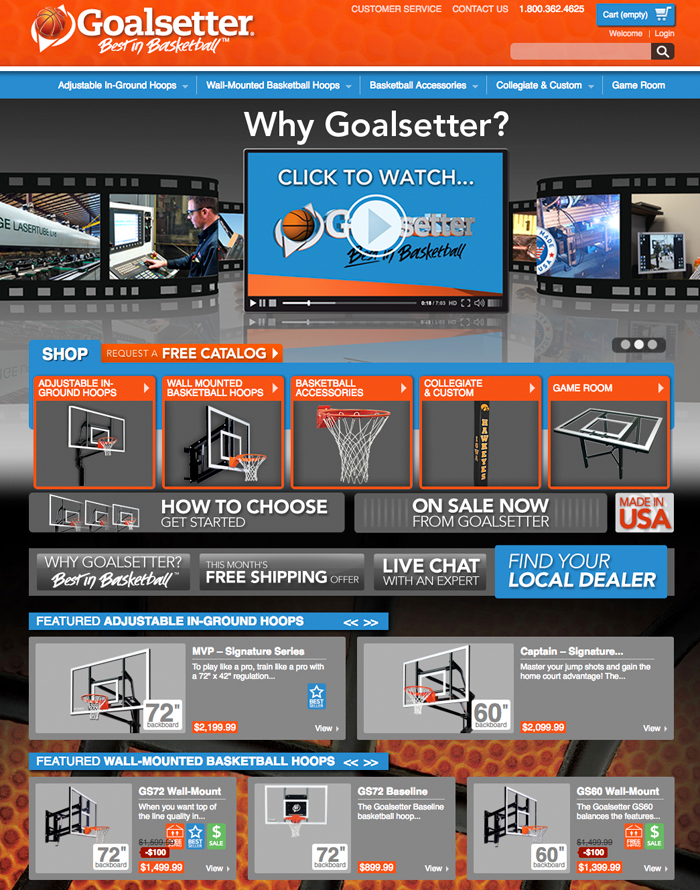
Image via Goalsetter
Goalsetter is a brand that produces recreational basketball hoops. The company’s product is incredibly durable backed by strong warranties. The brand derives its value from technical characteristics of the product. Their positioning, therefore, focuses on technical benefits rather than emotions or feelings. This positioning is reflected in the advertising video below.
Competition-Oriented
If you’re comparing your brand’s benefits to those offered by competitors, your brand positioning will be considered competition-oriented. Amazon’s advertising campaign for Kindle was largely based on the comparison of Kindle to Apple iPad. This type of brand positioning is mainly used by brands that are trying to disrupt the established order and challenge the leader.

Image via Amazon
iPad is used for a much broader range of activities compared to Kindle, a lot of which entails web browsing and isn’t as easy on the eyes for prolonged reading so Kindle attracts customers with their “reads like a book” claim.
Price-Driven
Branding is often perceived as a way to increase brand equity and drive a higher price point. But some companies choose to use low-prices as a pillar of their brand positioning. Ryanair, for example, draws on its low price point to establish itself as the most affordable airline in Europe.
Related: Brand Equity, How to Measure the Strength and Effectiveness of Your Brand
The Process of Writing a Positioning Statement
Writing a positioning statement isn’t tremendously difficult, but it does entail profiling, codifying and mapping out your brand together with research work to get a strong result.
Here is a step-by-step plan to creating a winning positioning statement:
Step 1. Analyze how your brand is currently positioning itself
Before you even start thinking about your brand positioning, you need to see your current brand positioning from a perspective of an outsider. If your company has been around for years, your brand already occupies a certain space in the customer mind.
Depending on where your brand is you might need to re-position or de-position it.
Re-positioning means changing the identity of the brand in the eyes of consumers.
De-positioning is an attempt to change the identity of competing for products so that your product can take up a space that others once occupied.
Related: Is It Time For A Rebrand? 4 Things To Consider Before Making The Change
Step 2. Identify your competitors and target market
Since positioning statement is meant to differentiate you from competitors, you need to have a thorough understanding of the marketplace. Note that you aren’t looking for the exact data on sales and market share, rather you need to understand how competitor products are perceived by customers.
Similarly, target market research is meant to give you an understanding of customer needs and wants. You can then use this knowledge to direct customer attention to benefits that are unique to your product and can elicit the maximum positive response from customers.
Step 3. Determine what differentiates you from competitors
Competitor research will give you a steady ground for your own positioning statement development. You’ll see what niches are already taken and what opportunities exist. Your job is to match identified opportunities with the benefits your product provides.
Related: Brand Innovation – How to Identify New Growth Opportunities
Bear in mind that benefits can be emotional as well as rational. And while you’re restricted by technical specs when it comes to rational benefits, the range of emotions is limitless and you can easily find those that aren’t utilized by competitors. For example, Gillette employs notions of technical prowess and masculinity, while Dollar Shave Club makes emphasis on humour and community.
Step 4. Craft a brand positioning statement
By now you have a clear understanding of your market, target audience, customer needs, and unique values of your product or service. To create your positioning statement use the template below:
For [target market description] who [target market need], [how our business offering meets the need]. Unlike [key competition], it [most distinguishing feature].
Here is another template you can use:
- What: The only [category]
- How: that [differentiation characteristic]
- Who: for [customer]
- Where: in [geographic location]
- Why: who [need state]
- When: during [underlying trend]
To illustrate how this template works, take a look at Harley Davidson positioning:
- The only motorcycle manufacturer
- That makes big, loud motorcycles
- For macho guys (and “macho wannabes”)
- Mostly in the United States
- Who wants to join a gang of cowboys
- In an era of decreasing personal freedom.

Image via Wiki Commons
Harley Davidson positioning statement creates a clear picture of what the company does and who they do it for. It also serves as a basis for brand’s tagline: American by birth. Rebel by choice.
As you can see, a brand positioning statement is an expression of all the assets that the company owns: from Purpose to Product, and to Infrastructure[6]. Each asset is developed separately, however, brand positioning statement brings those assets together and arranges them in a certain order: from emotional and intangible to rational and tangible.
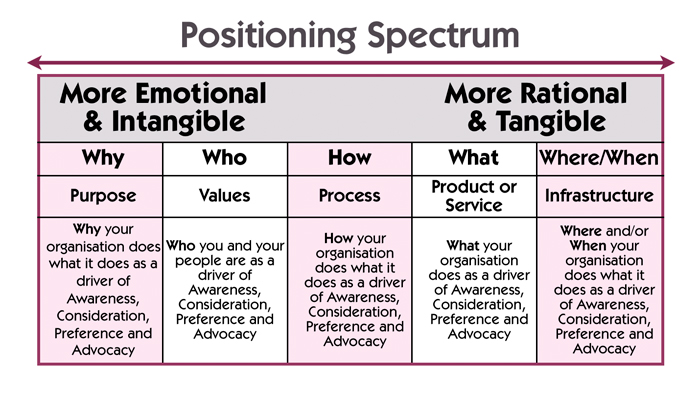
Step 5. Verify brand positioning
A powerful brand positioning statement is a great tool that brings focus to your brand strategy actions, marketing campaigns, and promotions. If used properly, this statement can help you differentiate your brand and win a significant share of the market.
To check the efficiency of your statement ask yourself these questions:
- Does it differentiate your brand?
- Does it allow for growth?
- Does it communicate your unique value?
- How difficult is it to copy?
- Is it memorable?
- Does it evoke strong emotions?
Final Word
Positioning gets you seen and remembered so it should never be handled as an afterthought. Positioning is an idea that should shape each and every aspect of your business including product development, brand strategy and marketing strategy, distribution tactics, creative direction, design and so forth.
You have to identify and decide on your brand positioning long before you start to worry about budgets and sales or design. Once you have your positioning statement, you need to constantly engage with your customers and apply consistent implementation to position your brand the right way so you can expand your market share, increase your sales and grow your business.
Inspired to finally take control of your brand positioning? The Personality Profile Performer™ System is the perfect DIY solution because it’s a step-by-step process empowering you to build your brand yourself and become more profitable. Get the Personality Profile Performer™ Programme here now so you can make your brand No.1 in your market.
If you want leadership direction and support transforming your brand so you’re empowered to identify your strong brand position and leverage it to the full to increase your sales then the Persona Brand Building Blueprint™ Mastermind is the perfect fit for you.
This is a two-day brand building intensive shared with a small group of like-minded peers where you work on your brand and fully map it out with our leadership to grow your business.

Build your standout brand at the Persona Brand Building Blueprint™ Mastermind with Lorraine Carter
Questions to ask yourself:
- What’s your current perceived position among customers?
- How is your current perceived position different or similar to existing brands?
- Does your positioning have long-term viability?
- What do you need to improve your presence?
- What core benefits do you offer that cut across all potential customers?
1. https://www.amazon.com/Positioning-Battle-Your-Al-Ries/dp/0071373586
2. http://www.forentrepreneurs.com/startup-ideation/
3. https://news.nationalgeographic.com/2017/05/deviate-science-seeing-perception-brain-beau-lotto/
4. https://hbr.org/2006/06/more-isnt-always-better
5. http://www.impactexecutives.com/books/play-bigger-how-rebels-and-innovators-create-new-categories-and-dominate-markets/
6. https://www.brandingstrategyinsider.com/2016/09/5-brand-positioning-models.html#.WluyAahl_IU

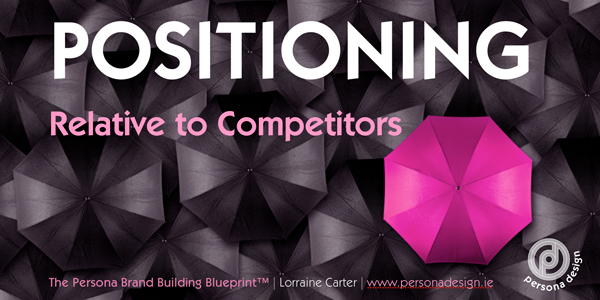



Leave a Reply
Want to join the discussion?Feel free to contribute!